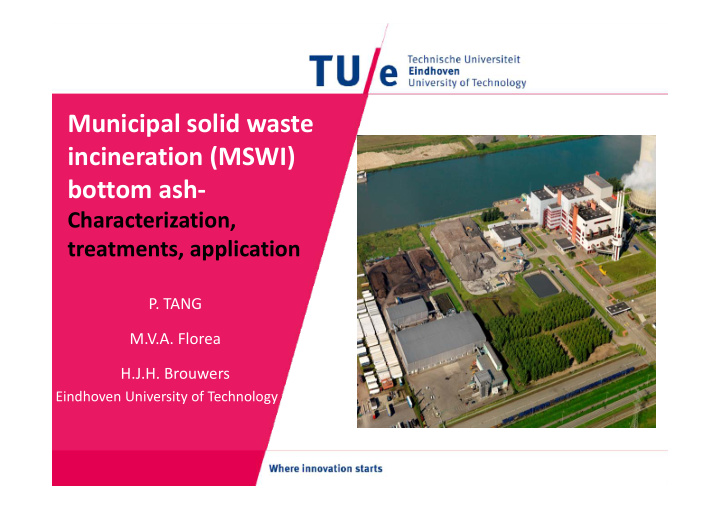



Municipal solid waste incineration (MSWI) bottom ash ‐ Characterization, treatments, application P. TANG M.V.A. Florea H.J.H. Brouwers Eindhoven University of Technology
Waste ‐ to ‐ energy plant Waste storage before incineration Scheme of the incineration system 1. MSWI bottom ash Wednesday, 29 June 2 2016
Municipal solid waste incineration Building material development 1) Reduction of solid waste 1) Consumption of raw materials 2) Generation of energy 2) Environmental pollution 3) Production of combustion residues 3) Energy consumption 4) Poor physical and chemical properties 4) Reuse and recycling of materials ? Environment Economy Sustainable development 2. Motivation Wednesday, 29 June 3 2016
(0.32) (0.9) (616) (1730) General treatments Separation – clean coarse aggregate • Fine fraction – higher amount of • contaminants 3. Characterization Wednesday, 29 June 4 2016
Influence on cement hydration (binder substitute) 3. Characterization Wednesday, 29 June 5 2016
Influence on mortar strength (sand replacement) 3. Characterization Wednesday, 29 June 6 2016
Wednesday, 29 June 7 4. Treatment 2016
Wednesday, 29 June 8 4. Treatment 2016
Washing Remove of soluble salts (chloride, sulphate) Thermal treatment Reduction of heavy metals leaching (Cu, Sb, etc.) Chemical extraction Extraction and recycle of metals Pelletization Recycle and reuse of fine bottom ash to produce artificial aggregate 4. Treatments Wednesday, 29 June 9 2016
Pelletizing technique ‐ agglomerating of powdery material into a shape of pellet Disc/pan Application field : pelletizer Mining ‐ iron ore Agriculture ‐ Fertilizer Biomedical field ‐ medicine production Recycling powder wastes to produce lightweight aggregate – sludge and dust, coal/MSWI fly ash, GGBS, etc. MSWI bottom ash fines (new) 5. Cold bonded pelletizing technique Wednesday, 29 June 10 2016
MSWI bottom ash fines properties ‐ negative Highly porous material Containing contaminants (heavy metals and salts) Metallic aluminum (expansion risk) High costs for general treatment Cold bonded pelletization with binders ‐ positive Controlling size for application in concrete Density control Pellet strength Spherical particle size for better flowability Immobilization by binders (S/S) Pre ‐ reaction of metallic aluminum Low cost 5. Cold bonded pelletizing technique Wednesday, 29 June 11 2016
Waste Values Cold bond technique MSWI bottom ash fines Artificial aggregates Stage 1 Stage 2 Stage 3 Characterization Technique study Properties of pellet Recipe design Optimization of recipe according to requirement Stage 4 Properties of concrete Environmental impact of artificial Application in concrete aggregate application Recycling 5. Cold bonded pelletizing technique Wednesday, 29 June 12 2016
1 2 3 1 2 3 5. Cold bonded pelletizing technique Wednesday, 29 June 13 2016
Properties of the artificial aggregates Specific density 2.5 g/cm 3 Loos bulk density 980 kg/m 3 belong to lightweight aggregate according to EN standards Crushing resistance 7.5 N/mm 2 higher than other artificial aggregate in literature The leaching of the sulphate, copper and antimony is well under limit value. 5. Cold bonded pelletizing technique Wednesday, 29 June 14 2016
5. Cold bonded pelletizing technique Wednesday, 29 June 15 2016
Bulk density ‐ decreased by 10% • Crushing resistance ‐ increased by 12 ‐ 22% • 5. Cold bonded pelletizing technique Wednesday, 29 June 16 2016
Thank you for your attention! Wednesday, 29 June 17 2016
Recommend
More recommend